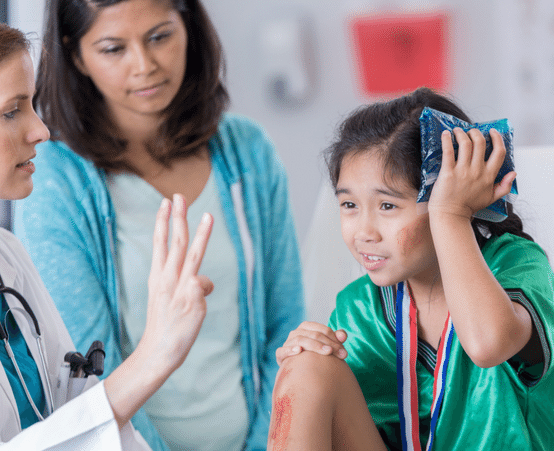Acquired brain injury

Brain injury in childhood has many different causes. If the brain injury occurs after birth, it is known as an acquired brain injury (ABI).
Acquired brain injuries can be caused by infections around the brain, strokes or events causing a lack of oxygen to the brain.
ABI also includes traumatic brain injuries (TBI) that happen after a head knock from falls or traffic accidents.
Brain injury can affect a child’s senses, movement, eating and swallowing. It can also impact concentration, attention, memory, speech, language, behaviour and emotions.
Some children will have temporary symptoms while others are permanent. Symptoms can range from mild to severe, depending on the severity of the injury.
Each child's recovery is unique. Learning to live with an ABI can be a long and difficult process, which is why ongoing research aims to improve the lives of children who have sustained an ABI.

Who does it affect?
Who does it affect?
- TBI occurs very frequently with around 600 to 1,600 traumatic brain injuries a year for every 100,000 children.
- Almost one in every 100 children in Australia is treated in emergency departments every year for traumatic brain injury.
- Traumatic brain injury is the leading cause of acquired disability and death for children in high-income countries such as Australia.
- Stroke occurs at high rates in young children.
- More than 3,000 children attend The Royal Children’s Hospital with TBI every year – some need a CT scan to rule out serious injury.
Our acquired brain injury research
Our acquired brain injury research
Our group, including researchers, service providers and educators, aims to share knowledge about interventions and outcomes for children with ABI.
Studies on ABI are investigating areas including mental health, parent and child-based interventions, social function and long-term outcomes.
Our research into long term outcomes after a traumatic brain injury has been running for over 20 years. We are combining all our research to date with research from other hospital sites across Australia and New Zealand to help us identify trajectories of recovery across the lifespan as well as risk, resilience and protective factors, to inform intervention strategies.
Concussion accounts for most mild traumatic brain injuries. Our research aims to improve the management of child concussion, detect those at risk for delayed recovery and develop treatments. We are investigating whether individualised treatment (which includes education, and physiotherapy and psychology) improves outcome and recovery time following a concussion.
We are also examining whether we can use a finger-prick blood test to help identify which children are at increased risk of prolonged concussion symptoms. This will allow us to commence treatment with these children early.
Childhood stroke affects 100-300 children and up to 5,000 newborns every year in Australia. Our childhood stroke research team have developed guidelines to improve the time it takes for stroke to be diagnosed and best practice for rehabilitation following stroke.
Impacts of our research

Impacts of our research
- We collaborated with Canadian researchers to find that blood samples can help gauge the severity of a TBI. The study found a protein can identify which children will recover well and who has the highest risk of ongoing problems requiring treatment, rehabilitation and support. Ongoing research is searching for other indicators.
- Our clinical practices guideline for managing communication and swallowing disorders after moderate-to-severe TBI ensures children receive the best care.
- We created Australia and New Zealand’s first set of clinical guidelines for children’s head injuries, which helps to ensure consistent care is provided in different emergency departments and helps identify TBI in children with seemingly mild injuries.
- An assessment and rehabilitation platform for children with movement disorders and ABI that we co-developed helps healthcare professionals conduct more efficient and accurate assessments, including remotely, to inform the best rehabilitation.
- Our long-term studies with TBI are continued through projects that focus on social and behavioural difficulties, plus family and child-based interventions, to improve quality of life and function.
- We developed Australia’s first clinical guidelines to improve the diagnosis and acute management of children who have a stroke. These aim to minimise brain injury and improve recovery.
Our vision
Our vision
Our vision is better diagnosis, management and treatment of brain injury, enabling improved recovery and fewer impacts on the brains and lives of affected children.
Where to next?
Where to next?
Current research is focused on interventions to improve mental health outcomes and quality of life after ABI. We are working with families with lived experience to help improve our models of care.



